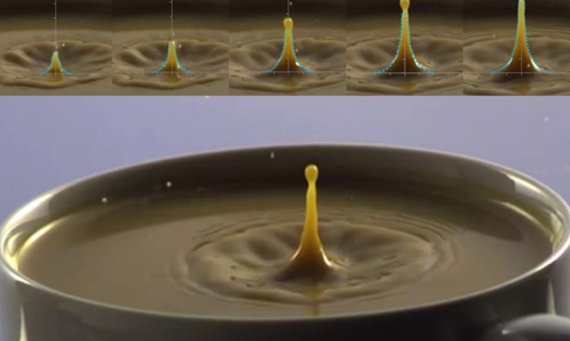© Cees van Rijn/WUR
It has actually been a ten-year-long hobby project, Van Rijn admits frankly. An interesting side path of his work as Professor by special appointment in Microfluidics and Nanotechnology for Food and Health. It started as it usually does: through amazement and wonder. About fluid jets, that is; the Eiffel-Tower-shaped forms that arise when a droplet falls into a fluid. Nespresso uses it beautifully in their coffee advertisements.
Eiffel Towers
‘Just look around you at a swimming pool, or when it rains’, Van Rijn says. ‘You will see little Eiffel Towers everywhere. It’s really quick – those little towers only last for several dozen milliseconds, but they are discernible to the naked eye.’ There had to be a process behind this mechanic, Van Rijn thought to himself. ‘That’s when I started thinking, diving into literature and experimenting. What are the forces at play here?’ And now, he has finally found the answer.
The liquid in the jet that falls down again does not feel gravity.
Cees van Rijn
According to Van Rijn, the phenomenon of the water jet was never adequately explained. And he thinks it is because none of the scientific descriptions include the surface tension as a dynamic force in the origin of the nascency of the jet. ‘That’s when it struck me. This couldn’t be true!’ The result is a theory in which surface tension takes the centre stage. Moreover, a theory which is fully supported by measurements.
Falling droplet
The trick to it, Van Rijn says, is to perceive the water jet as a mass of water in free fall. When the water column is falling, there is no gravity inside the jet. ‘The surface tension pulls the water down an produces an additional acceleration.’ This additional acceleration is also responsible for the differences in pressure at different heights within the jet. The higher the jet and the narrower the liquid column, the higher the pressure.
Young-Laplace
Together, the pressure differences and the surface tension are responsible for the Eiffel-Tower-shaped curve of the jet. By applying and solving an equation similar to the Young-Laplace equation, Van Rijn was able to reproduce the curve mathematically. The Young-Laplace equation determines the shape of a lying or hanging droplet in a gravitational field. Van Rijn demonstrated that when slightly modified, the equation can also describe other water phenomena.
One always sees the same shape form when water splashes.
Cees van Rijn
Van Rijn’s model is easy to verify experimentally. To perform the measurements, he used a high-speed camera that records 6000 frames per second. This is fast enough to freeze the jet formation, which only lasts for several dozen milliseconds. The measurements of the jet seamlessly support the theory. Better yet: according to Van Rijn, the jet measurements are ‘a sensitive way to measure dynamic surface tensions’.
The Eiffel Tower shape is universal for droplets that splash, Van Rijn says. ‘One always sees the same shape form when water splashes: a tower with a pear-shaped bulge above it that often detaches. The size of the jet only depends on the surface tension, the density of the liquid and the acceleration at which the tower is pulled down as a consequence of the surface tension.’
Inspiring
Now remains the question why the Eiffel Tower has the exact shape of a water jet. Van Rijn suspects it is no mere coincidence. ‘The tower was built in 1887. The first photographs of water jets had already been taken ten years prior. Eiffel could have seen those. The running theory is that the tower was given this shape to catch the least possible amount of wind. But other shapes would have met that requirement as well. I do not exclude the possibility that Gustave Eiffel was inspired by the water jet.’


